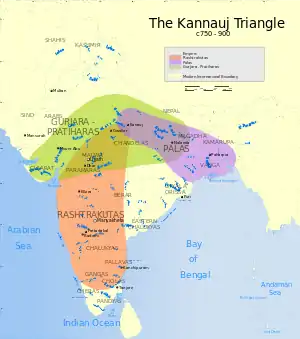| Mahendrapala | |
|---|---|
 Pala empire with neighbours | |
| Pala Emperor | |
| Reign | c. 845–860 |
| Predecessor | Devapala |
| Successor | Shurapala I |
| Dynasty | Pala |
| Father | Devapala |
| Mother | Mahata Devi |
Mahendrapala (Bengali: মহেন্দ্রপাল) (r. c. 845–860[1]) was the fourth king of the Pala dynasty of the Bengal region of the Indian subcontinent. He was the son of Devapala and his queen Mahata.[2]
Reign
-_State_Archaeological_Museum_in_West_Bengal-_1%252C_Satyen_Roy_Rd%252C_Auddy_Bagan_Basti%252C_Behala%252C_Kolkata%252C_West_Bengal_700034-_First_Floor-_Nandadirghi_Vihara%252C_Jagjivanpur_Gallery.jpg.webp)
Mahendrapala has been mentioned in some Pala records, but earlier, the historians used to believe that these mentions referred to the Gurjara-Pratihara king Mahendrapala I. However, the discovery of the Jagjivanpur copper plate charter issued by Mahendrapala made it clear that he was a distinct Pala emperor, who succeeded Devapala.[3] The charter, issued in the 7th year of Mahendrapala's reign (believed to be 854 CE), mentions the construction of a monastery at Nandadirghika Udranga by Mahendrapala's mahasenapati ("great general") Vajradeva.[4] The grant is dated in his 7th regnal year and issued from the Kuddalakhataka jayaskandhavara (the camp of victory).[5]
Mahendrapala was succeeded by Shurapala I.[6] According to the Jagjivanpur inscription, Shurapala I was Mahendrapala's younger brother and royal envoy.[7]
Mahendrapala appears to have retained the Pala control over Bengal, Bihar and Uttar Pradesh. He possibly carried out further campaigns against the Hunas and the Utkalas, and passed his empire intact to his younger brother and successor, Shurapala I.[8]
See also
References
- ↑ Dilip Kumar Ganguly (1994). Ancient India, History and Archaeology. Abhinav. p. 41. ISBN 978-81-7017-304-5.
- ↑ Dimensions of Human Cultures in Central India: Professor S.K. Tiwari Felicitation Volume. Sarup & Sons. 2001. p. 239. ISBN 978-81-7625-186-0.
- ↑ Debala Mitra; Gouriswar Bhattacharya (1991). Akṣayanīvī: Essays Presented to Dr. Debala Mitra in Admiration of Her Scholarly Contributions. Sri Satguru Publications. ISBN 978-81-7030-275-9.
- ↑ Bengal museum to reconstruct excavated Buddhist site
- ↑ "Jagjivanpur, A newly discovered Buddhist site in west Bengal". Information & Cultural Affairs Department, Government of West Bengal website. Archived from the original on 9 August 2009. Retrieved 18 October 2009.
- ↑ Paresh Chandra Das Gupta; Asok Kumar Datta (1 January 1991). Studies in Archaeology: Papers Presented in Memory of P.C. Dasgupta. Books & Books. ISBN 978-81-85016-29-0.
- ↑ Niharranjan Ray; Brajadulal Chattopadhyaya (1 January 2000). A Sourcebook of Indian Civilization. Orient Blackswan. pp. 621–623. ISBN 978-81-250-1871-1.
- ↑ Bhattacharya, Suresh Chandra, Pāla Kings in the Badal Praśasti — A Stock-Taking, Journal of Ancient Indian History, University of Calcutta, Vol. XXIV, 2007-08, pp. 73-82.